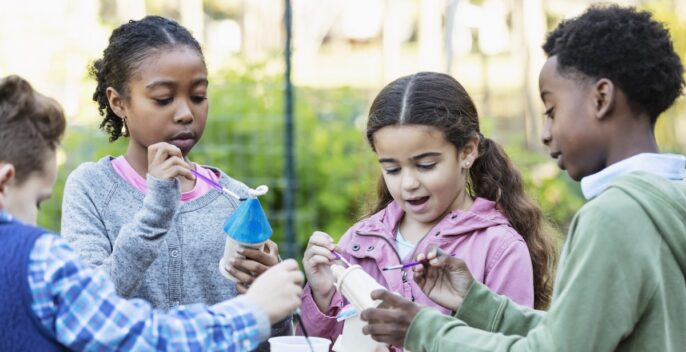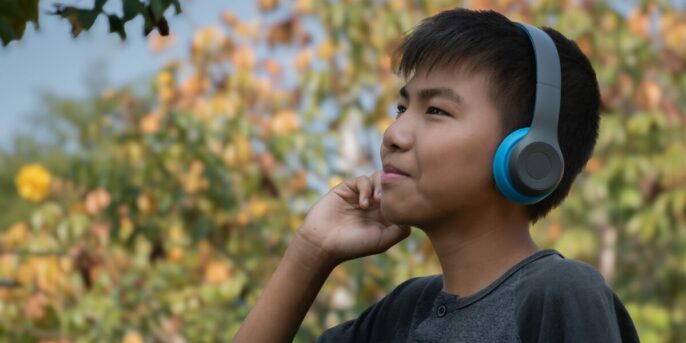Thirty-five senior citizens in t-shirts and track bottoms push their hands firmly down on their mats, stretching their backs in unison. Three fifteen-year-old girls demonstrate the yoga pose from the front of the open dance studio, describing the benefits it will bring them.
Welcome to Project GROW!—a dynamic leadership program specifically for girls in secondary school, aimed at empowering them to contribute meaningfully to their communities. Through a curated network of alumni and nonprofit partners, these learners connect with causes they care about and devise unique, action-based solutions to address them. The projects are real, and the stakes are, too. Project GROW! embodies the opportunity for girls to direct the learning process, making education meaningful and truly learner-centered.
Some student teams lead play-based activities to improve parent-child relationships in partnership with the nonprofit Playright. Others develop menus, logos, and social media campaigns to attract new customers to a café run by people with learning disabilities, in partnership with Nesbitt Centre. Still, others create board games to raise awareness of declining aquatic plant and animal species, in partnership with Ocean Park.
The benefits are mutual. The learners increase their confidence, initiative, and management skills, while nonprofits expand their impact. And it’s all possible because of one shift in the way Marymount Secondary School approached learning: transitioning from classroom-based to community-connected experiences.
Marymount Secondary School isn’t alone in reimagining learning through a community-centric, learner-centered lens. Patana International School in Thailand is reorganizing learning experiences around local sustainable development goals. VIS Better Lab School in Taiwan is redesigning its core classes around community partner needs. And KP International School in Thailand is reimagining textbook-based lessons to apply to businesses outside their front door.
Each school is using a simple 12-step framework to help learning become more learner-centered. These schools have chosen Shift #12: moving from classroom-based to community-connected learning. However, other schools have chosen Shift #2: moving from content-led to inquiry-based experiences. Still, others have adopted Shift #6: moving from worksheet-based problems to solving real-world problems through products or services.
After uncovering the nonprofit and community needs, we asked the learners to align their passions and propose dynamic projects for their partnering NGOs. Through Zoom project pitches, learners shared their ideas and received feedback from the nonprofits to advance their proposals.
Some students proposed board games to teach others how to protect the horseshoe crab population. Others developed logos, menus, and social media promotions to help the Adult with Disabilities Café attract more customers. Still, others designed exercise activities to help the elderly live happier, healthier lives.
Consider: How might a pitch session help connect your community stakeholders on projects? What format makes sense in your context?
Vivian, a Year 9 student, discusses the value of these pitches for her development: “I think that it’s really fun and exciting to pitch our ideas because usually, we wouldn’t be able to present our prototype to a larger audience. You can also get constructive feedback to improve your thinking, problem-solving, and design thinking skills.”
Aligning Purpose and Passion in a Project
Protecting the local horseshoe crab population, promoting fitness in the elderly, providing employment for people with disabilities, and increasing play in urban areas are all causes you would be hard-pressed to find anyone disagreeing with. The challenge is coordinating impactful, community-driven projects to advance these causes.
In learner-centered environments, you always start with the learners.
To accelerate the process, Marymount learners took field trips to nonprofits to observe their activities, conduct interviews with the populations they serve, and gather ideas from similar organizations.
These trips helped students hone in on specific areas of need to build their projects around.
Project Development and Implementation
- 90 students
- 15 student teams
- 15 projects
- 15 adult facilitators/mentors
- 3 leaders
- 1 partnering learning design organization
- 12 alumni
- 8 partnering nonprofits
The numbers above represent the community members involved in the GROW! leadership projects. For two and a half hours every week, the walls of the classroom came down in exchange for an open, flexible, project-based environment that involved a community of stakeholders.
- Students selected project tasks based on their strengths.
- Teachers mentored students in small teams, helping them source materials, develop products, and resolve conflicts.
- Leaders engaged directly by chaperoning outings and coordinating partnerships.
- Alumni facilitated strategic communication between the school and nonprofit organizations.
- Nonprofits integrated insights from a fresh youth perspective into their missions.
Here’s what Hannah, a Year 9 student who partnered with the Red Cross, had to say: “You encounter more challenges than in traditional classrooms. But it also helps you gain experience in overcoming those challenges and thinking about how to address different situations.”
At the end of June, the entire community was invited back together for a dynamic GROW! Exhibition. In tandem with partnering nonprofits, students detailed the journey of their projects and the impact on them as learners.
The learners increased their confidence, initiative, and management skills, while nonprofits expanded their impact. And it was all possible because of one shift in the way Marymount Secondary School approached learning: transitioning from classroom-based to community-connected experiences.
Kyle Wagner
The Power of an Alumni Network
Through regular events, fundraisers, publications, and newsletters, Marymount kept its alumni network informed and invested in their former school’s success. So, it wasn’t surprising when they reached out about this new initiative to grow leadership skills in their learners. Alumni who worked directly in or with local nonprofits were eager to get involved and provide a direct window into the issues and needs of the communities they serve.
At the onset of a community partnership, excitement will certainly be high, and expectations even higher. To manage them, it’s important to lay out the roles and responsibilities of each stakeholder.
Insights and Call to Action
It would be disingenuous to say that the GROW! program was an unparalleled success. Many student teams lost motivation, some projects fell flat, a few nonprofit partners dropped out, and some student-led workshops were unattended. Here are some tips I have learned from serving as a community connector:
- Keep it short: This was a year-long undertaking; I recommend making it a 6-8 week experience to maintain engagement and momentum.
- Define a few projects ahead of time: Defining a few projects will help student teams struggling to come up with ideas have something to move forward with.
- Collect more input from students: Getting learner feedback regularly will help you make necessary changes to keep them engaged and motivated.
- Agree on a communication channel: Emails are the worst way to facilitate ongoing collaboration. I recommend a WhatsApp group, Discord channel, or Slack.
- Create agreed-upon deadlines: Establishing deadlines for work will help ensure projects stay on track and that students are working towards goals.
Marymount created GROW! to shift learning from the classroom to the community.
How about you? What shifts will you make to create a more learner-centered environment?
I have an entire book full of ideas and case studies to support you: Where is the Teacher: The 12 Shifts for Student-Centered Environments. You can also use this 12 Shifts Scorecard to help identify a few areas of focus.
Here’s to breaking down the walls between classroom and community!




